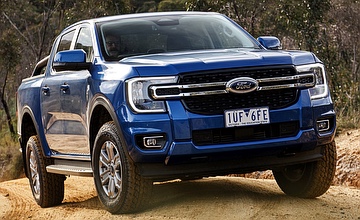2023 Ford Ranger first drive review

ON SALE now from $35,930 and topping out at $70,190 (all before on-road costs), the T6.2 Ranger finally arrives after more than six years in development, with Ford Australia’s design and engineering centre in the north of Melbourne again being the mid-sized pick-up’s global home room.
The cabin has been completely redesigned, with the adoption of a reach-adjustable steering column at last, as well as an all-new dashboard offering a choice of portrait touchscreens, digital instrumentation, revamped storage, an overhauled heater/ventilation system for more effective climate control. Buyers also score new seats and different cabin trim offering higher-quality materials.
Under the boxy new bonnet are three engine choices, two of which are new to Ranger.
The XL is powered by a 2.0-litre four-cylinder single turbo-diesel. Usurping the old 2.2-litre unit, it makes 125kW of power at 3500rpm and 405Nm of torque between 1750-2500rpm, and is only available as a six-speed torque-converter automatic (6R80).
From the XLS up is the 2.0-litre twin-turbo diesel version of the above, badged BiTurbo. Producing 154kW at 3750rpm and 500Nm from 1750rpm to 2000rpm, it is mated to a completely revised 10-speed torque-converter auto (10R80). It employs a fly-by-wire mechanism known as ‘e-shifter’.
Perhaps the most eagerly awaited single item on the new Ranger is the new 3.0-litre V6 turbo-diesel. Optional for $3000 extra in the XLT, Sport and Wildtrak, it delivers 184kW at 3250rpm and 600Nm at 1750-2250rpm, and also employs the 10R80 gearbox.
The 2.0-litre four-pot Ranger 4WDs employ updated versions of the old part-time 4x4 set-up with 4x2 (rear-drive), 4x4 Low range and 4x4 High range, but the 3.0-litre V6 steps things up with a new electronic on-demand four-wheel-drive system.
Taking in extensive research from most major markets around the world, the goal was to improve everyday useability, comfort, refinement, safety, durability, on-road driveability, off-road capability and overall efficiency.
Front tracks are 50mm wider, the front wheels pushed forward by 50mm and overhang is reduced, leading to a redesign of the front suspension, as being further outboard means longer-travel springs and components can be used, benefitting off-road traction.
All Rangers bar Raptor offer a maximum towing capability of 3500kg (the latter’s is 2500kg). Payloads vary from 934kg to 1441kg, depending on model.
Suspension changes include a redesigned independent wishbone coil-sprung front end, with more-outboard dampers for a greater tuning range and a comfier ride, while the rear has new leaf springs (four per side).
Has the design and development team in Victoria done us proud? You bet.
